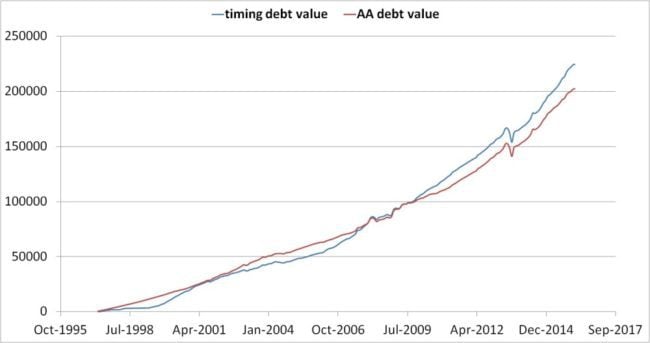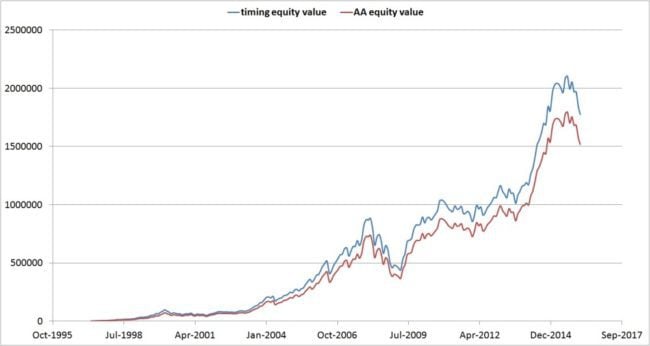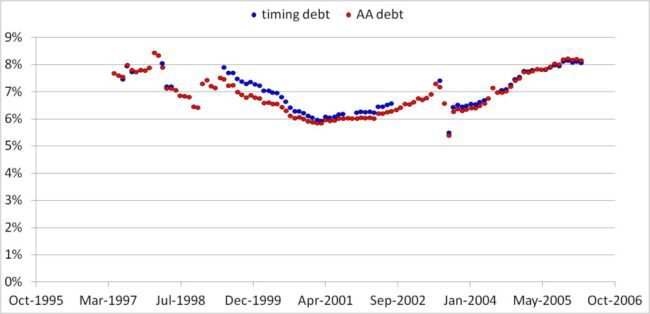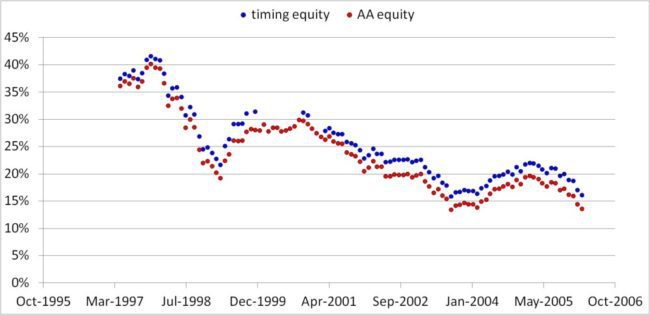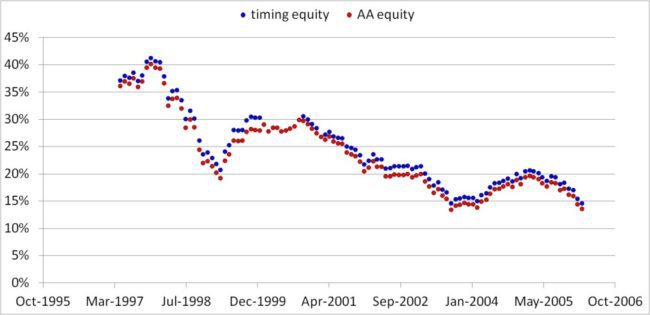Last Updated on September 4, 2018 at 9:49 am
Here is an analysis of a mutual fund SIP investment in which purchases are systematically ‘timed’ using an index PE.
I made this analysis following the suggestion of ET Wealth analyst/columnist Dr. Narendra Nathan (@drnarendranET) after (or amidst!) some fierce discussion over the usefulness of the SIP.
The SIP is a useful way to invest (something I have been doing for close to 8 years and intend to continue). However, we must recognise that there is a conflict of interest when a salesman says ‘do not stop your SIPs’ and ‘do not time the market’! For the AMC and the distributor, the SIP is a way to obtain constant income.
Dr. Narendra Narthan’s point is that the investor could do better if the Index PE is used as a guideline to ‘time’ investing. I had earlier written about this: Are Mutual Fund SIPs Suitable for Disciplined Long-Term Investors? where I refer to systematic PE based investing as SI-PE.
Join 32,000+ readers and get free money management solutions delivered to your inbox! Subscribe to get posts via email! (Link takes you to our email sign-up form)
🔥Want to create a complete financial plan? Learn goal-based investing? Exclusive access to our DIY tools? Increase your income with your skills? Use this link to enjoy massive discounts on our robo-advisory tool & courses! 🔥
I write this post with a huge amount of trepidation. Running a backtest is quite easy. All it requires is interest and some Excel skills. Is it however, responsible? I am inclined to say no, especially because I tend to get emails that go,’you wrote XYZ on abc date and I started to invest like that‘. I do not have the health to emotionally handle that!
That said, it is also incorrect to not publish an analysis and present it as an ‘alternative’ with an open mind. That is all the following is.
THIS POST IS NOT A RECOMMENDATION TO STOP YOUR SIPS. I will not be held responsible if your investing habits are influenced by it.
Index PE based Mutual Fund SIP Investing
While the debate on SIPs was unfolding on twitter (my handle is @freefincal), Balaji Swaminathan was conducting an independent analysis on the Sensex PE. Therefore, I used his insights for the following study:
Franklin Prima Plus fund was chosen as the example of a diversified equity fund (across caps and sectors).
Franklin Dynamic Accrual fund was chosen as an example of a diversified debt fund (it has recently become more of a credit opportunities fund with only corporate bonds)
Analysis period: April 1997 to Feb 2016.
Monthly investment: Rs. 1000
Sensex PE rules:
PE >20, invest 100% in debt fund
PE <15, invest 100% in equity fund
15<PE<20, invest as per asset allocation (60% in equity fund and 40% in debt fund).
No fund switching or rebalancing was considered to avoid tax and exit load issues.
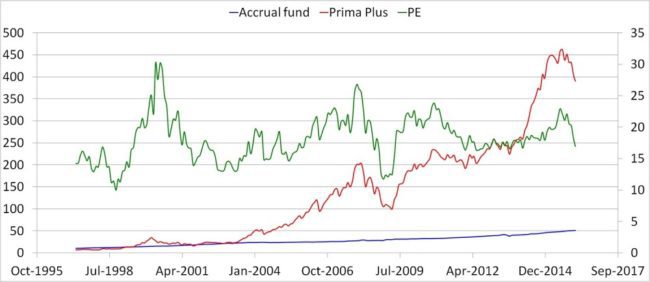
Here the ‘timing value’ represents the results of SI-PE and ‘AA value’ represents SIP with asset allocation: AA-SIP
It is not surprising that SI-PE has resulted in a larger corpus
SI-PE (Equity corpus): 17.76 Lakhs XIRR: 23.1%
AA-PE (Equity corpus): 15.2 Lakhs XIRR: 22.1%
Considering the amount invested, that is a significant different in corpus.
SI-PE (Debt corpus): 2.24Lakhs XIRR: (cannot be calculated*)
AA-PE (Debt corpus): 2.02 Lakhs XIRR: 7.93% (before tax)
If you think that is a big difference so be it. The way I see it, the extra corpus did not come free. You had to work for it. Easy to claim that PE is easy to track etc. but it is still non-zero time and effort.
Therefore, considering the completely automated way of investing, SIP has done quite well.
* XIRR sometimes cannot be calculated! Read more: IRR/XIRR – Excel – Limitations of Calculating Complex Cash Flow Returns
Wait just a minute!
The SIP duration above was 19 years! We don’t have enough data to perform a rolling SIP return analysis. So how about a 10-year SIP.
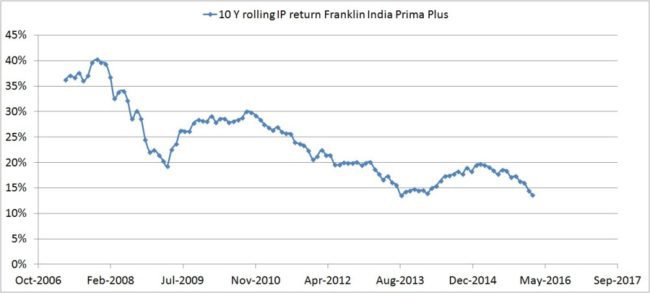
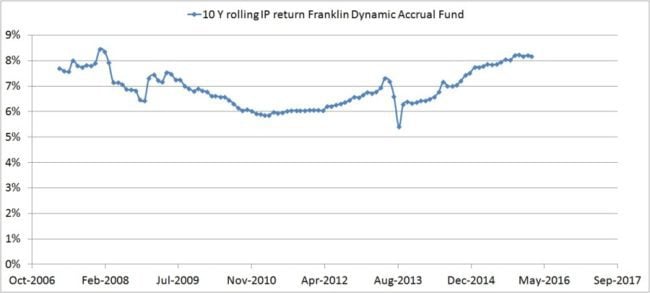
Rolling AA-SIP vs SI-PE analysis (10 years)
For some intervals, the SI-PE XIRR could not be computed. So clearly SI-PE is superior to AA-SIP. It is worth the effort though?
At least for the assumptions made here, SI-PE returns are as volatile as AA-SIP returns. So timing the market (in this instance) does not reduce rolling SIP volatility.
There is a clear and definite benefit of investing based on the index PE values (you can choose index you like – perhaps BSE or NSE 500 to get a broader market perspective). However, there is also an effort and discipline involved. Quite easy to backtest. Not so easy to implement in real life.
To be fair, the good old SIP does not fair too poorly at all.
Wait a minute, how about
PE >22, invest 100% in debt fund
PE <15, invest 100% in equity fund
15<PE<20, invest as per asset allocation (70% in equity fund and 30% in debt fund).
No fund switching or rebalancing to avoid tax and exit load issues.
Results are not too different!
We must recognise that these PE limits are based on limited hindsight and we could be wrong.
In this study I changed the asset allocation of the amount invested alone. Perhaps I should have changed the asset allocation of holdings. Perhaps I should not have invested in the debt fund and waited for PE to correct and then invested as a lump sum. Perhaps, perhaps, perhaps ….
Can I make significantly reduce return volatility associated with the SIP by ‘some timing method’? I won’t bet on it.
I still think that a SIP done with asset allocation in mind, with periodic reviews and de-risking prior to a goal will work. ‘Timing’ is likely to provide a higher corpus and better returns, but at a price.
At the end of the day it is ‘personal’ finance. However, it should not be ‘clouded’ by conflict of interest in the name of behavioural finance, if can catch my drift…
My key takeaway: If I want to reduce portfolio volatility, I must change the asset allocation of existing holdings. I want only higher returns but with same volatility, change only asset allocation of future investments, and do not touch existing holdings.

Use our Robo-advisory Tool to create a complete financial plan! ⇐More than 3,000 investors and advisors use this! Use the discount code: robo25 for a 20% discount. Plan your retirement (early, normal, before, and after), as well as non-recurring financial goals (such as child education) and recurring financial goals (like holidays and appliance purchases). The tool would help anyone aged 18 to 80 plan for their retirement, as well as six other non-recurring financial goals and four recurring financial goals, with a detailed cash flow summary.
🔥You can also avail massive discounts on our courses and the freefincal investor circle! 🔥& join our community of 8000+ users!
Track your mutual funds and stock investments with this Google Sheet!
We also publish monthly equity mutual funds, debt and hybrid mutual funds, index funds, and ETF screeners, as well as momentum and low-volatility stock screeners.
You can follow our articles on Google News

We have over 1,000 videos on YouTube!

Join our WhatsApp Channel



- Do you have a comment about the above article? Reach out to us on Twitter: @freefincal or @pattufreefincal
- Have a question? Subscribe to our newsletter using the form below.
- Hit 'reply' to any email from us! We do not offer personalised investment advice. We can write a detailed article without mentioning your name if you have a generic question.
Join 32,000+ readers and get free money management solutions delivered to your inbox! Subscribe to get posts via email! (Link takes you to our email sign-up form)
About The Author
 Dr M. Pattabiraman (PhD) is the founder, managing editor and primary author of freefincal. He is an associate professor at the Indian Institute of Technology, Madras. He has over 13 years of experience publishing news analysis, research and financial product development. Connect with him via Twitter(X), LinkedIn, or YouTube. Pattabiraman has co-authored three print books: (1) You can be rich too with goal-based investing (CNBC TV18) for DIY investors. (2) Gamechanger for young earners. (3) Chinchu Gets a Superpower! for kids. He has also written seven other free e-books on various money management topics. He is a patron and co-founder of “Fee-only India,” an organisation promoting unbiased, commission-free, AUM-independent investment advice.
Dr M. Pattabiraman (PhD) is the founder, managing editor and primary author of freefincal. He is an associate professor at the Indian Institute of Technology, Madras. He has over 13 years of experience publishing news analysis, research and financial product development. Connect with him via Twitter(X), LinkedIn, or YouTube. Pattabiraman has co-authored three print books: (1) You can be rich too with goal-based investing (CNBC TV18) for DIY investors. (2) Gamechanger for young earners. (3) Chinchu Gets a Superpower! for kids. He has also written seven other free e-books on various money management topics. He is a patron and co-founder of “Fee-only India,” an organisation promoting unbiased, commission-free, AUM-independent investment advice.Our flagship course! Learn to manage your portfolio like a pro to achieve your goals regardless of market conditions! ⇐ More than 3,500 investors and advisors are part of our exclusive community! Get clarity on how to plan for your goals and achieve the necessary corpus no matter the market condition!! Watch the first lecture for free! One-time payment! No recurring fees! Life-long access to videos! Reduce fear, uncertainty and doubt while investing! Learn how to plan for your goals before and after retirement with confidence.
Increase your income by getting people to pay for your skills! ⇐ More than 800 salaried employees, entrepreneurs and financial advisors are part of our exclusive community! Learn how to get people to pay for your skills! Whether you are a professional or small business owner seeking more clients through online visibility, or a salaried individual looking for a side income or passive income, we will show you how to achieve this by showcasing your skills and building a community that trusts and pays you. (watch 1st lecture for free). One-time payment! No recurring fees! Life-long access to videos!
Our book for kids: “Chinchu Gets a Superpower!” is now available!


Must-read book even for adults! This is something that every parent should teach their kids right from their young age. The importance of money management and decision making based on their wants and needs. Very nicely written in simple terms. - Arun.Buy the book: Chinchu gets a superpower for your child!
How to profit from content writing: Our new ebook is for those interested in getting a side income via content writing. It is available at a 50% discount for Rs. 500 only!
Do you want to check if the market is overvalued or undervalued? Use our market valuation tool (it will work with any index!), or get the Tactical Buy/Sell timing tool!
We publish monthly mutual fund screeners and momentum, low-volatility stock screeners.
About freefincal & its content policy. Freefincal is a News Media organisation dedicated to providing original analysis, reports, reviews and insights on mutual funds, stocks, investing, retirement and personal finance developments. We do so without conflict of interest and bias. Follow us on Google News. Freefincal serves more than three million readers a year (5 million page views) with articles based only on factual information and detailed analysis by its authors. All statements made will be verified with credible and knowledgeable sources before publication. Freefincal does not publish paid articles, promotions, PR, satire or opinions without data. All opinions will be inferences backed by verifiable, reproducible evidence/data. Contact Information: To get in touch, please use our contact form. (Sponsored posts or paid collaborations will not be entertained.)
Connect with us on social media
- Twitter @freefincal
- Subscribe to our YouTube Videos
- Posts feed via Feedburner.
Our publications
You Can Be Rich Too with Goal-Based Investing
 Published by CNBC TV18, this book is designed to help you ask the right questions and find the correct answers. Additionally, it comes with nine online calculators, allowing you to create custom solutions tailored to your lifestyle. Get it now.
Published by CNBC TV18, this book is designed to help you ask the right questions and find the correct answers. Additionally, it comes with nine online calculators, allowing you to create custom solutions tailored to your lifestyle. Get it now.Gamechanger: Forget Startups, Join Corporate & Still Live the Rich Life You Want
 This book is designed for young earners to get their basics right from the start! It will also help you travel to exotic places at a low cost! Get it or gift it to a young earner.
This book is designed for young earners to get their basics right from the start! It will also help you travel to exotic places at a low cost! Get it or gift it to a young earner.Your Ultimate Guide to Travel
 This is an in-depth exploration of vacation planning, including finding affordable flights, budget accommodations, and practical travel tips. It also examines the benefits of travelling slowly, both financially and psychologically, with links to relevant web pages and guidance at every step. Get the PDF for Rs 300 (instant download)
This is an in-depth exploration of vacation planning, including finding affordable flights, budget accommodations, and practical travel tips. It also examines the benefits of travelling slowly, both financially and psychologically, with links to relevant web pages and guidance at every step. Get the PDF for Rs 300 (instant download)